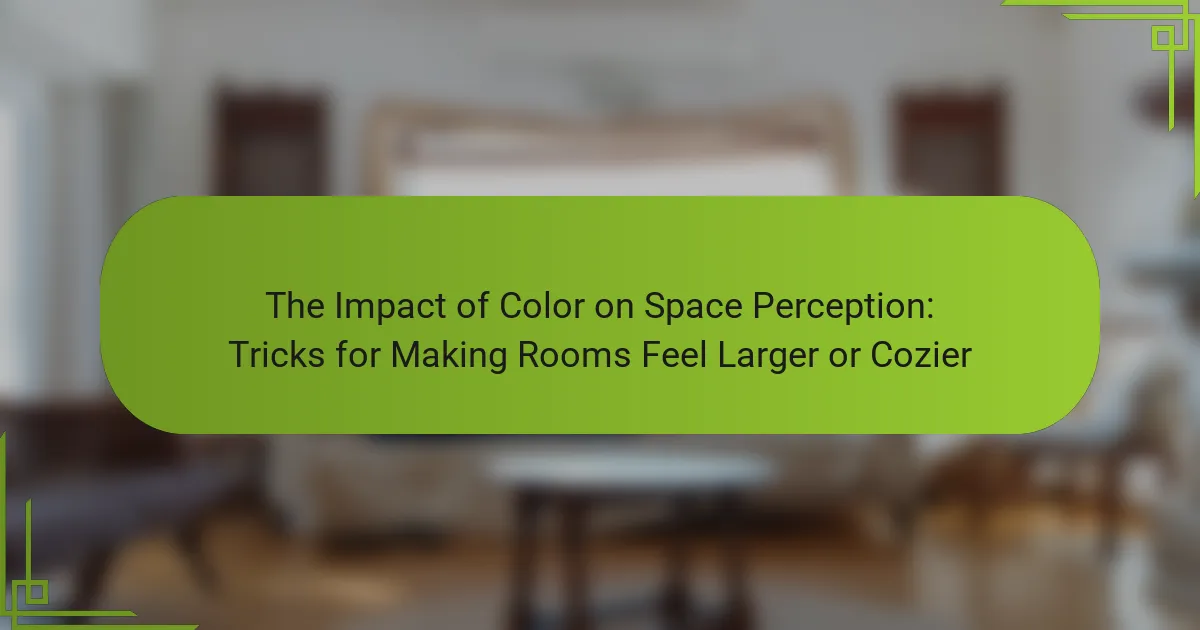
What is the Impact of Color on Space Perception?
Color significantly influences space perception by altering how we perceive dimensions and distances. Lighter colors tend to create an illusion of larger spaces. In contrast, darker colors can make areas feel smaller and more intimate. For example, a room painted in soft pastels appears more expansive than one with deep, rich hues. Research indicates that color temperature also affects perception; warmer colors can evoke a sense of coziness, while cooler tones may feel more open. Studies show that color can impact mood, which indirectly influences how we perceive space. For instance, blue hues are often associated with calmness and spaciousness, enhancing the feeling of openness in a room.
How does color influence our perception of space?
Color significantly influences our perception of space. Lighter colors tend to make a room feel larger and more open. Darker colors can create a sense of coziness but may also make a space feel smaller. Warm colors, like reds and yellows, can energize a space, while cool colors, such as blues and greens, often promote calmness. Studies show that color can affect our mood and even our sense of time in a space. For example, a study published in the journal “Color Research and Application” found that lighter shades can enhance the perception of spaciousness. Color choice can be a powerful tool in interior design, influencing how we interact with and feel in a given environment.
What psychological effects do colors have on our feelings of space?
Colors significantly influence our feelings of space. Lighter colors, such as whites and pastels, tend to create an illusion of openness. They reflect more light, making rooms appear larger and airier. Conversely, darker colors can make spaces feel smaller and more enclosed. This effect occurs because dark shades absorb light, reducing perceived space.
Research indicates that blue hues can evoke calmness and spaciousness. A study published in the journal “Color Research and Application” found that blue tones create a sense of tranquility and expansiveness. Warm colors, like reds and oranges, may induce feelings of coziness but can also make a room feel more confined.
The choice of color can manipulate emotional responses to space. Overall, color selection plays a vital role in how we perceive and experience our environments.
How does lighting interact with color to affect space perception?
Lighting interacts with color to significantly affect space perception. Bright lighting enhances the vibrancy of colors, making spaces feel more open and inviting. Conversely, dim lighting can dull colors, creating a cozier, more intimate atmosphere. The color temperature of lighting also plays a role; warm light can make colors appear softer and more welcoming, while cool light can create a more expansive feel. Studies show that well-lit spaces with lighter colors can increase perceived area by up to 20%. Thus, the combination of lighting and color influences how spacious or confined a room feels.
Why is understanding color important in interior design?
Understanding color is crucial in interior design because it influences mood, perception, and space. Color can create a sense of warmth or coolness in a room. It can also make spaces appear larger or cozier, depending on the shades used. For example, lighter colors tend to open up a space, while darker hues can create intimacy. Studies show that color affects psychological responses, impacting emotions and behavior. The right color choices can enhance the functionality of a room. Therefore, mastering color theory is essential for effective interior design.
What role does color play in creating ambiance?
Color significantly influences ambiance in a space. It affects mood, perception, and emotional responses. Warm colors like red and orange create energy and warmth. Cool colors such as blue and green promote calmness and relaxation. Light colors can make a room feel larger and more open. Dark colors often create a sense of intimacy and coziness. Research shows that color can impact feelings of comfort and safety. A study by the University of California found that color affects psychological well-being. Therefore, choosing the right colors is crucial for setting the desired atmosphere in a room.
How can color choice affect room functionality?
Color choice significantly impacts room functionality by influencing mood, perception of space, and usability. Light colors can make a room feel larger and more open. Dark colors often create a cozy and intimate atmosphere but can make spaces feel smaller. For example, studies show that blue tones can enhance focus and productivity, making them ideal for workspaces. In contrast, warm colors like red and orange can stimulate energy and conversation, suitable for social areas. The psychological effects of color are well-documented, with research indicating that color can affect emotions and behaviors. Thus, selecting appropriate colors is crucial for optimizing room functionality.

What are the tricks for making rooms feel larger?
To make rooms feel larger, use light colors on walls and ceilings. Light colors reflect more light, creating an illusion of space. Mirrors can also enhance this effect by reflecting light and views. Choose furniture with legs to create an airy feel. Avoid heavy drapes; opt for sheer curtains to maximize natural light. Use multi-functional furniture to reduce clutter. Keep the room organized and free of unnecessary items. Finally, utilize vertical space with tall shelves to draw the eye upward.
Which colors are best for creating an illusion of space?
Light colors are best for creating an illusion of space. Soft shades like pale blue, light gray, and off-white reflect more light. This reflection makes a room feel airy and open. Dark colors absorb light, which can make spaces feel smaller. According to color theory, lighter hues expand visual boundaries. A study from the University of Southern California found that lighter colors influence spatial perception positively. Hence, using light colors effectively enhances the sense of space in a room.
What light colors can make a room appear larger?
Light colors such as white, light gray, pale blue, and soft beige can make a room appear larger. These colors reflect more light, creating an illusion of spaciousness. White walls can enhance natural light, making the room feel airy and open. Light gray provides a subtle contrast while still reflecting light effectively. Pale blue can evoke a sense of calm and openness, contributing to a larger feel. Soft beige adds warmth without overwhelming the space, maintaining a light atmosphere. Overall, these light colors work together to visually expand the dimensions of a room.
How do accent walls influence spatial perception?
Accent walls can significantly influence spatial perception. They create a focal point in a room, drawing attention and altering visual dynamics. A darker accent wall can make a space feel cozier by visually reducing its size. Conversely, a lighter accent wall can enhance openness and make a room feel larger. Research indicates that color contrast affects depth perception. A study by the University of Southern California found that contrasting colors can manipulate how we perceive distances in a space. This shows that accent walls can effectively change the perceived dimensions of a room.
What design techniques enhance the feeling of spaciousness?
Using light colors enhances the feeling of spaciousness in a room. Light shades reflect more natural light, making spaces appear larger. White, soft pastels, and light neutrals are effective choices. Mirrors can also create an illusion of depth. Placing mirrors opposite windows maximizes light reflection. Open floor plans reduce visual barriers, contributing to a sense of openness. Minimalist furniture arrangements maintain clear pathways, preventing clutter. Vertical lines in design can draw the eye upward, enhancing height perception. Lastly, using large-scale art can create focal points without overwhelming the space.
How does furniture arrangement impact the perception of room size?
Furniture arrangement significantly influences the perception of room size. Strategic placement can create an illusion of spaciousness. For example, arranging furniture away from walls can promote a more open feel. Additionally, using multi-functional furniture helps reduce clutter, enhancing the sense of space. Clear pathways between furniture pieces also contribute to a more expansive perception. Furthermore, the scale of furniture matters; smaller pieces can make a room feel larger. Research indicates that open layouts are often perceived as more spacious. In contrast, overcrowded arrangements can make a room feel cramped and smaller.
What role does mirror placement play in creating a larger feel?
Mirror placement significantly enhances the perception of space in a room. Strategically positioning mirrors can reflect light and create an illusion of depth. This effect makes a room appear larger than its actual dimensions. Placing mirrors across from windows maximizes natural light, further contributing to the spacious feel. Additionally, mirrors can visually expand narrow areas, such as hallways. Research indicates that reflective surfaces can increase the perceived size of a space by up to 30%. Therefore, effective mirror placement is a crucial element in interior design for creating a more open atmosphere.

What are the tricks for making rooms feel cozier?
To make rooms feel cozier, incorporate soft textures, warm colors, and layered lighting. Soft textiles like blankets and cushions create a welcoming atmosphere. Warm colors such as deep reds, oranges, and browns evoke comfort. Layered lighting, including table lamps and string lights, adds warmth and reduces harshness. Personal touches, like family photos or artwork, enhance emotional connection. Plants or natural elements introduce life and freshness. Rugs can define spaces and add warmth underfoot. These elements collectively contribute to a more inviting and intimate environment.
Which colors are ideal for creating a cozy atmosphere?
Warm colors are ideal for creating a cozy atmosphere. These include shades like deep reds, warm oranges, and soft yellows. Such colors evoke feelings of warmth and comfort. They can make a space feel inviting and intimate. Studies show that warm colors can stimulate feelings of happiness and relaxation. For instance, research indicates that red can increase energy levels and warmth perception. Additionally, earthy tones like browns and greens also contribute to a cozy ambiance. These colors connect spaces to nature, enhancing comfort. Overall, using a palette of warm and earthy tones can effectively create a cozy environment.
What warm colors contribute to a feeling of comfort?
Warm colors that contribute to a feeling of comfort include red, orange, and yellow. Red is associated with warmth and energy, often creating a cozy atmosphere. Orange evokes feelings of enthusiasm and warmth, making spaces feel inviting. Yellow is linked to happiness and positivity, enhancing feelings of comfort in a room. Studies show that these colors can stimulate emotional responses. For instance, research indicates that warm colors can increase feelings of warmth and comfort in living spaces. This evidence supports the idea that incorporating warm colors can enhance the overall comfort of a room.
How do darker colors impact the coziness of a space?
Darker colors enhance the coziness of a space by creating a sense of intimacy. They absorb light, making a room feel more enclosed and inviting. This effect can lead to a warm and snug atmosphere. Research indicates that darker shades can evoke feelings of comfort and safety. For example, studies show that people often associate dark colors with warmth and relaxation. Additionally, darker hues can make furniture and decor stand out, adding to the overall cozy feel. Overall, the use of darker colors in interior design effectively contributes to a more comfortable environment.
What design elements can enhance a cozy environment?
Warm color palettes enhance a cozy environment. Colors like soft browns, warm reds, and muted yellows create inviting spaces. Textures also play a crucial role. Incorporating soft fabrics, such as plush rugs and knitted throws, adds warmth. Layered lighting, including table lamps and candles, provides a soft glow. Furniture arrangement influences coziness; intimate seating arrangements encourage conversation. Personal touches, like family photos and art, create a sense of belonging. Natural elements, such as plants, bring life and tranquility. These design elements collectively foster a warm and inviting atmosphere.
How can textiles and patterns contribute to a cozy feel?
Textiles and patterns significantly contribute to a cozy feel by enhancing warmth and comfort in a space. Soft fabrics like wool, fleece, and cotton create inviting textures. These materials invite touch and promote relaxation. Patterns, such as florals or plaids, add visual interest and warmth. They can evoke feelings of nostalgia and comfort. Layering textiles, like throws and cushions, creates depth and softness. Studies show that tactile experiences influence emotional responses. Cozy environments often feature a mix of textures and patterns, fostering a sense of homeliness.
What lighting options are best for creating warmth in a room?
Warm lighting options include soft white LED bulbs and incandescent lamps. These lighting types emit a warm color temperature, typically between 2700K and 3000K. Warm lighting creates a cozy atmosphere and enhances the feeling of comfort in a room. Additionally, dimmable lights allow for adjustable brightness, further contributing to warmth. Table lamps and floor lamps with warm-toned bulbs can also add to the ambiance. Using multiple light sources, such as wall sconces and string lights, can create layers of warmth. Research shows that warm lighting positively affects mood and relaxation. Thus, choosing the right lighting options can significantly influence the perceived warmth of a space.
What practical tips can help in choosing colors for space perception?
Choosing colors wisely can significantly influence space perception. Light colors, such as whites and pastels, create an airy feel. Dark colors tend to absorb light, making spaces feel smaller. Use monochromatic color schemes to create cohesion and expand visual space. Accent walls can add depth without overwhelming the room. Consider the room’s natural light; brighter spaces can handle bolder colors. In smaller areas, opt for cool colors to promote a sense of calm and spaciousness. Warm colors can make larger spaces feel cozier. Textures and finishes also impact perception; matte finishes can soften light, while glossy finishes reflect it, altering the visual space.
The main entity of the article is the impact of color on space perception. The article explores how color influences our perception of dimensions and distances, highlighting that lighter colors can create a sense of spaciousness while darker colors evoke intimacy. It discusses the psychological effects of colors on mood and space, the interaction between lighting and color, and practical tips for using color to enhance room functionality. Additionally, the article provides strategies for making rooms feel larger or cozier through color choice, furniture arrangement, and design elements.
